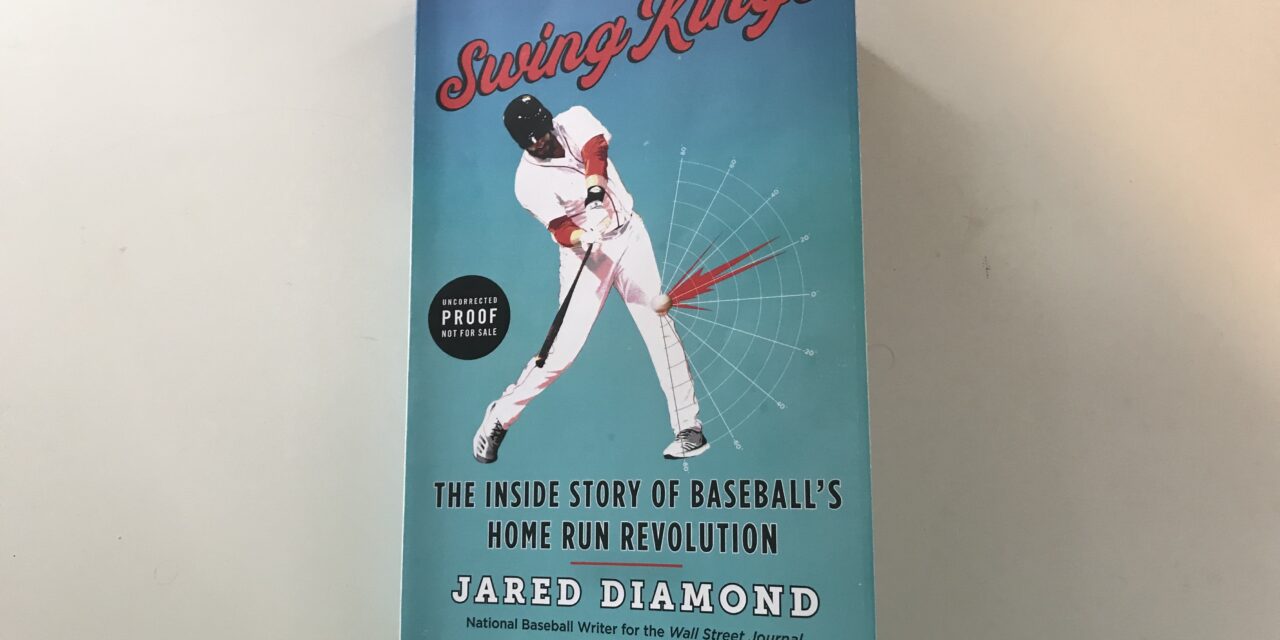
A first edition, uncorrected proof of Swing Kings by Jared Diamond. [Ryan Kolakowski]
By Jared Diamond. 336 pp. $28.99
In Swing Kings, Jared Diamond unearths chance encounters, unlikely coaches and stark technique changes responsible for transforming pedestrian batters into Major League Baseball’s elite sluggers. Diamond illustrates the precise moments when today’s power hitters — the likes of J.D. Martinez and Aaron Judge — discovered the need to deconstruct and rebuild their swings to succeed in a league with a short leash for failure. The Wall Street Journal’s national baseball writer provides readers with a personal view of the lightbulb moments that drove players to unconventional hitting instructors who led baseball’s home run revolution.
Diamond introduces Swing Kings with a story familiar to many baseball players. At 15 years old, he found the perfect swing for one game and launched three towering fly balls to right field, the first time he ever displayed such power. The next day, that majestic strength evaporated. Through the rest of his first book, Diamond explores how baseball’s best permanently unlock the perfect swing.
For Martinez, the need for change was sparked by a lackluster 2013 campaign and an improbable glimpse of Ryan Braun’s approach on a TV at Minute Maid Park. That moment led him to Craig Wallenbrock, the coach who mentored Braun, Michael Young and other big league stars. For Judge, a miserable 2016 skid led to private lessons with an obscure hitting guru. For Marlon Byrd, it was a 2012 PED suspension and a lucky meeting with Doug Latta, one of Wallenbrock’s colleagues, in a California parking lot.
The need for change led each player to baseball outsiders who broke with traditional coaching norms. Rather than teaching clients to “swing down,” these coaches preached baseball heresy, encouraging hitters to work under the ball and “finish high” with a David Ortiz-like follow-through.
Diamond, a former Mets beat reporter, takes only two dozen pages before introducing Justin Turner, the light-hitting utility-man in New York turned All Star third baseman in Los Angeles. Turner, 28 years old in 2013, never thought he could be a slugger, but his predestined role as a singles hitter started to fade when he began taking advice from a resurgent Marlon Byrd.
Byrd joined the Mets on a minor league deal after transforming his swing with Latta and finding success in the Mexican Pacific Winter League. He slugged 21 home runs and posted an .848 OPS over 117 games with New York, but coaches barred the outfielder from sharing his technique with other players.
“Byrd was all but banned from discussing hitting with his teammates, so he wouldn’t corrupt them with his radical new swing,” Diamond writes. “But as the season went on, Turner started asking Byrd questions.”
Turner declined to alter his swing until the Mets traded Byrd to Pittsburgh on August 27. On that date, Turner owned a .638 OPS with no home runs, so he made a change and followed Byrd’s advice. In 16 games from August 28 until the end of the 2013 season, Turner slashed .340/.365/.540 with four doubles and two home runs. That December, the Mets cut him.
In six years since, Turner owns an .887 OPS and 112 home runs with the Los Angeles Dodgers — concrete evidence of change.
Turner and Byrd are not the lone Mets in Diamond’s first book. The reporter devotes several pages to Daniel Murphy and his magical home run surge through the 2015 postseason. Murphy, too, made subtle changes and picked up on Byrd’s tendencies — with some help from Mets hitting coach Kevin Long — to add power to his game.
“In many ways,” Diamond writes, “the modern-day fly-ball revolution started because Byrd willed it into existence.”
Martinez, Judge, Byrd, Turner and Murphy all follow the same trend by bucking with conventional wisdom, according to Diamond. Swing Kings details how modern sluggers learned to imitate Babe Ruth, Hank Aaron and the great hitters of the past. Diamond shows readers how baseball’s home run revolution is not a change from what the game’s best have always done, but a widespread adoption of exemplary hitting technique – the unlocking of baseball’s perfect swing.
















